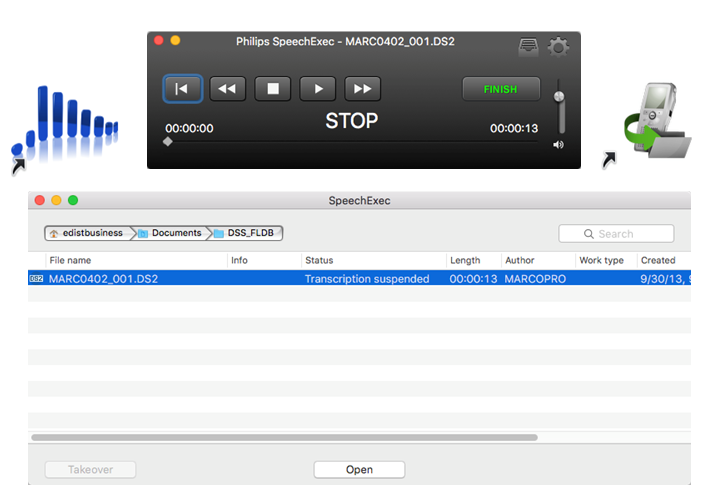Philips and the Mac OS
If you’re familiar with the Windows implementation of Philips’ professional documentation and workflow software, SpeechExec Pro, you know that the application is replete with configurations and customizations, and supports both normal and complex documentation workflows.
Unfortunately, that is not the case with the Mac edition of the software. Using SpeechExec for Mac, you’ll be facing these limitations:
- Cannot set author names, worktypes, or recording formats on recorder
- Doesn’t play encrypted files and does not encrypt files
- Won’t auto-launch SpeechExec when docking a recorder
- No backup function
- No file format conversion
- No email or FTP support
- No Dragon speech recognition integration
- No templates
- No direct recording – This means you cannot plug a mic into the Mac and record files in SpeechExec.
- Cannot upload lists to the DPM
- No encryption
If these aren’t deal breakers, or you aren’t necessarily concerned with what the Windows version offers, read on.
Requirements
When it comes to dictating and transcribing on the Mac, most of you will really need two applications:
- SpeechExec for Mac – Plays back dictations and requires a license
- DPMConnect for Mac – Downloads dictations and does not require a license
These are separate programs, and must be installed individually. In this article, we’re going to cover just SpeechExec for Mac – but fear not. Here’s an overview of DPM Connect for Mac.
Operating Systems
You should be running the latest version of SpeechExec for Mac, v1.2.04, which can be downloaded here. It supports OS X Mavericks (10.9) and Yosemite (10.10), but unfortunately not El Capitan (10.11). The latest version of DPMConnect does not support OS X 10.11 either.
*UPDATE: SpeechExec for Mac v1.3.07 is now available and supports both OS X El Capitan (10.11) and Sierra (10.12). Additionally, there is a newer version of DPMConnect for Mac, v1.5.01, which also supports El Capitan and Sierra.
Here’s how to check your Mac operating system.
Playback Formats
SpeechExec for Mac will play DS2 files and almost nothing else – not even standard DSS extension recordings. The one exception is ADPCM-encoded WAV files, if you can record in that format.
By the way, WAV recording on the DPM8000 does not use ADPCM encoding, but the Philips Mobile Recorder smartphone app for Android does. And the app is free.
Download Formats
DPMConnect will only download DSS and DS2 files.
SpeechExec for Mac Features
Now that we’ve spent some time on requirements and limitations, let’s talk about what SpeechExec for Mac can do for documentation.
Worklist
The main browser window, called the worklist, allows you to navigate to your recordings, wherever you have stored them. Use the breadcrumbs at the top to move from one folder to another, and type keywords in the search box (to the right) to find specific dictations.
Your files will download into the Documents directory by default, but this can be changed in DPMConnect for Mac.
Your worklist also has sortable metadata columns, but these cannot be moved or removed. And the [Takeover] button (at the bottom) allows you to transcribe dictations that another user is working on.
Playback and Transcription
Play recordings by clicking [Open], or double-clicking the dictation. A playback window will open, displaying the name of the file and basic play controls. When transcription is complete, click [Finish]. Depending on what you selected in the Preferences menu, your file may change status, or it may seem to disappear from the worklist. More on that in a moment.
View the properties of any dictation from either the worklist, by right clicking, or the playback window, by clicking the file drawer icon. These properties cannot be edited – only viewed.
Once you start transcribing a file, [Discard] will reset the file without saving anything, and [Suspend] will allow you to save without finishing.
If you suspend a recording, you cannot change status back to “Transcription pending” yourself – you can only finish the file. File status probably doesn’t matter much in your environment, though, so this shouldn’t be a significant concern.
Preferences Menu
Let’s look at the configuration options available in SpeechExec for Mac, which are located under the Preferences menu. This menu can be accessed by going to SpeechExec > Preferences, or by clicking the gear icon in the playback window.
In Preferences, you get to customize a total of three functions:
- How fast your dictation rewinds or fast forwards (winding speed)
- How many seconds your file rewinds when resuming playback after stopping (auto backspace)
- Whether or not you want dictations to go to the “Transcribed” folder when you mark them as finished (by clicking the [Finish] button in the player)
Networking
Networking is available in SpeechExec for Mac, but it’s a two part setup. For now, if you want to be able to see a network location (where you are storing files), you’ll need to click Go > Go to folder in the top menu. Once you do that, you can access the full file structure of your Mac. Otherwise, you’ll be stuck within a particular subset of Mac directories, and won’t be able to see network locations.
If you click Go > Go to parent folder, your worklist will back up one level in the file path, to the folder above it. Ultimately, you’ll get to the root directory of the current Mac user, which is as high as you can go without using the Go > Go to folder function.

